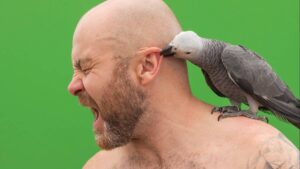Dr Boreham’s Crucible: Excessive sweater? Botanix is here to get you fit for public consumption again

Picture: Getty Images
Botanix (ASX:BOT) has renounced the weed.
Unlike rapper and enthusiastic lifetime cannabis consumer Snoop Dog, however, this time it’s for real.
A current inhabitant of ‘Cannabis Corner’, Botanix focused on developing synthetic cannabinoid treatments for skin diseases including acne, atopic dermatitis and psoriasis, and is looking to partner or licence the programs.
Results were patchy, but no sweat! The company has moved on and is pursuing US Food and Drug Administration approval for a non-cannabis treatment called primary axillary hyperhidrosis (PAH).
When diagnosed with this exotic-sounding malady, unwitting patients could be excused for thinking they have been given a death sentence. In reality, PAH is excessive sweating well beyond what the body needs to excrete to maintain a normal temperature.
Many of those affected become reclusive, lest they die of embarrassment.
“They are silent suffers,” says Botanix chief Dr Howie McKibbon. “They plan their day around when they think it will happen and go out as little as possible.”
In May last year Botanix obtained the rights to the substance sofpironium bromide, renamed Sofdra, which addresses the problem by suppressing underarm receptors (see below).
After being rebuffed by the US Food and Drug Administration over concerns about the wording of instructions, the company is ready to front the regulator again and is confident of getting to market by mid-2024.
Meanwhile, the company has raised a further $13.5 million via an institutional placement, having gathered $12.5 million in July.
More than skin deep
Botanix listed in July 2016 via the back door, using the shelf of Perth-based biotech Bone Medical.
The accompanying capital raise raised $3.5 million at two cents apiece.
Botanix’s US-based management team has launched more than 30 dermatological drugs, so its experience is more than skin-deep.
Headquartered in Perth, but based in Philadelphia, Botanix was founded by parties including current executive director Matt Callahan, Caperi (a financial investor) and scientist and non-executive director Robert Bosch.
Aptly, the Philadelphia-based Callahan is a lawyer. He also founded Iceutica Inc and Churchill Pharma, having co-invented Iceutica’s drug delivery platform.
Following the death of chair Graham Griffiths in February 2019, Vince Ippolito was appointed as executive chair. Ippolito had been chief commercial officer with the Nasdaq-listed inflammatory diseases house Anacor, which Pfizer acquired for $US5.2 billion in 2016.
The company’s chief operating officer since May 2019, Dr McKibbon was anointed CEO in August this year.
Based in Phoenix, Arizona, Dr McKibbon was a former vice prez at Dermavant Sciences and held senior positions at Anacor and Medicis.
In May last year, Botanix acquired the sofpironium bromide asset from the Nasdaq-listed Brickell Biotech, now Fresh Tracks Therapeutics, for an upfront $US4 million plus various other milestones and royalties (see below).
Brickell had taken the program to pivotal study stage, successfully completing a 700-patient trial. And then decided it wanted to adopt an unrelated early-stage discovery program.
In September 2020, Brickell’s (and now Botanix’s) Japanese partner Kaken Pharmaceuticals won approval to sell a five per cent formulation of the drug, which it calls Ecclock with sales off to a flying start.
No sweat
Caused by physiological rather than psychological factors, PAH normally becomes apparent in youths aged 12 to 17 years – the time in their lives they really don’t want to be whiffy.
The excessive sweating comes in three iterations: primary axillary (under the arms), cranio-facial (head and face), palmar (hands and palms) and plantar (feet).
The company is seeking FDA approval for the first.
Sofdra works by inhibiting M3 muscarinic receptors in eccrine glands at the application site. Found throughout the body, these receptors induce a ‘fight or flight’ response, including sweating and salivating, lactation and even urination.
“There are a number of potential applications,” Dr McKibbon says.
With 16 million sufferers, primary axillary hyperhidrosis is the third biggest dermatological condition behind acne and dermatitis (with rosacea vying for third).
Last year, Botanix applied for FDA consent, but in September this year the agency responded with a ‘complete response letter’ – a.k.a as ‘do some more work and try again’.
The knock-back wasn’t as bad as it seemed at first blush, as the objections pertained to the instructions in the box rather than a demand for more trials or clinical work.
For example, the regulator demands the addition of the term “applicator” as well as reformatting the instruction sheet so it didn’t fold. Patients also needed to be told to wash their hands after use.
Sofdra is intended to be sold in the US at 15 per cent strength.
The company has now been assured by the FDA that no work needs to be done and it plans to re-lodge the entreaty by the end of March next year, with approval targeted for mid-2024 and launch shortly thereafter.
The company estimates a market of 16 million sufferers in the US, only 3.2 million of whom have sought treatment.
Treatments to data include a double lashing of the Old Spice, Drysol (aluminium chloride) or – more radically – Botox or surgery (nerve cutting, which can result in over compensatory sweating in other areas).
Aluminium chloride is used cauterizing wounds and can cause burns. Botox requires 30 needles in each arm pit once every three months and invasive surgery is – well – invasive.
Dial-a-drug
Meanwhile, the company can access US dermatologists with a small force of 20-30 sales representatives. While there are 50,000 general practitioners in the US, there are about 10,000 dermatologists, of which only 3,500 write scripts for medical conditions.
But the company’s market research shows that it is partly because of the patients reclusive nature, and most can be accessed via digital channels.
In October 2023, the company signed a deal with US telehealth pioneer Upscript Health, offering direct-to-consumer access to one million patients.
The deal is exclusive, in that Upscript will facilitate primary axillary hyperhidrosis scripts only for Botanix. There’s nothing to stop Botanix forging alliances with other telehealth providers, but it plans to focus on Upscript.
Dr McKibbon adds that telehealth is the way of the future, given the rapid contraction of the physical footprint of US pharmacies.
More than skin deep
Botanix also has an exclusive licence to a device called Permetrex, a dermal delivery device allowing 10 to 20 times more of the active ingredient to get through the skin, which it was originally using with its marijuana products.
“We haven’t applied Permetrex to [the program] yet because we would have to study is separately,” Dr McKibbon says.
“But down the line it could extend the product’s technology life or into other dermatological indications.”
Usual topical treatments contain chemicals (permeation enhancers) that open the skin pores just enough for a drug to sneak through.
Where’s the evidence?
Botanix inherited a completed two-stage pivotal Phase 3 trial from Brickell, dubbed ‘Cardigan’.
Cardigan is a synonym for sweater – get it? – which shows that even medical researchers are not devoid of a sense of humor. When the highway cops tell them to ‘pull over’ they’re the guys who respond: ‘It’s a jumper, actually’.
Anyway, the heartening results showed an average two-point improvement in the HDSM-Ax (hyperhidrosis disease severity measure – axillary) scale of patient-reported sweating severity.
“Almost nine in 10 patients had a one-point improvement, which is important because it is only a four-point scale,” Dr McKibbon says.
“At four, you are sweating through your shirt to the point past plain embarrassment, to the inability to interact with people.
“At three, your shirt is drenched to the point where it is very noticeable.”
Other programs
Meanwhile, Botanix has parked its cannabinoid-based programs for rosacea, acne and atopic dermatitis (severe eczema), but they remain on the books for possible partnering deals.
The most advanced secondary program is for rosacea, which affects about five per cent of the population.
Rosacea causes broken veins and strong redness. So, the next time you see an older person with a bulbous nose and ruddy cheeks, don’t assume that they have been hitting the sherry too hard.
Acne needs no introduction as the enemy of many an adolescent’s love life. Or looking on the bright side – a preventative of many a teenage pregnancy.
In October 2019, the company’s pimple hopes were popped when a Phase 2 trial of its synthetic cannabinoid did not meet its primary endpoint, but a Phase 1b atopic dermatitis study showed better results.
Finances and performance
Having raised $23 million in the 2022-’23 financial year, Botanix went to the well in July to raise $12.5 million in a placement at 12 cents apiece (a three per cent discount to the previous day’s closing price).
Last month the company raised a further $13.5 million at 13 cents apiece (a 16 per cent discount).
The first raising was mainly to fund the $8 million repurchase of milestones and royalties payable to Fresh Tracks Therapeutics (formerly Brickell).
The liabilities – including $US4 million payable on European or UK approval – far exceeded this amount. But Fresh Tracks entered the seemingly unfavorable deal because it wanted to invest in separate early-stage programs.
Post raising, the company has cash of $20 million “more than enough” to get to commercialisation.
Botanix shares peaked at 27 cents in mid-September 2019 and over the last 12 months have been as low as 6.9 cents (mid-January 2019).
Botanix share price today
Dr Boreham’s diagnosis:
Botanix cites industry estimates of a current US$1.6 billion worth for the primary axillary hyperhidrosis market.
Of course, every drug developer outlines Big Numbers, but in this case Botanix has evidence in the form of promising Japanese sales, from which the company derives a royalty.
In the September quarter, Kaken reported Ecclock sales of 700 million yen ($7.3 million), up 71 per cent and updated its full-year sales target to 2.1 billion yen.
Broker Euroz Hartleys extrapolates annual US Sofdra revenues of US$239 million, based on an average (reimbursed) price of US$540 a month.
The firm values Botanix shares at 31 cents – more than twice their current worth.
“If you believe only half the numbers it is still a good story,” Dr McKibbon chimes.
He adds that US dermatology products are regularly – and widely – used off label.
Indeed – that’s why strabismus (cross-eyed) treatment Botox is used for cosmetic enhancement, diabetes drug Ozempic has been hijacked for weight loss and hypertension drug Viagra is used for … you know what.
Disclosure: Dr Boreham is not a qualified medical practitioner and does not possess a doctorate of any sort. He tries not to sweat the small stuff but has a bottle of Brut 33 on hand just in case.
This column first appeared in Biotech Daily
Related Topics
UNLOCK INSIGHTS
Discover the untold stories of emerging ASX stocks.
Daily news and expert analysis, it's free to subscribe.
By proceeding, you confirm you understand that we handle personal information in accordance with our Privacy Policy.








